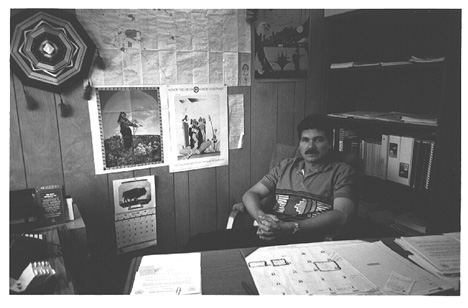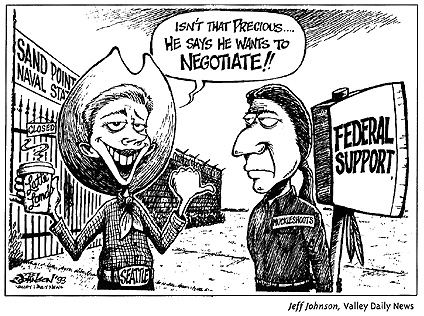by Matt Robesch
The Free Press
Native Americans are retaking control of their own destiny. On some reservations this means opening casinos, exploiting white America's gambling vice and using the profits to improve life on Native sovereign soil. On other reservations, community colleges are opening and Native students are being educated about their past.
Then there are the Tribes who have educated themselves in the art of federal law, learned the game inside and out, and can now take on the government where it lives - in the halls of Congress and the courts of law.
There's such a Tribe in King County.
The Muckleshoots once fished and hunted in an area stretching from Mount Rainier to present-day Edmonds. Eventually, all Pacific Northwest Tribes found themselves in the Oregon Territory.
In 1854 and 1855, the federal government of the United States of America and the Muckleshoot Tribe signed two treaties - the Point Elliott and the Medicine Creek. The treaties granted the Tribe a plot of land and the right to continue fishing in the area's numerous rivers. In the 1950s and '60s, much of their land was encroached upon, "often over the voiced objection of the Tribe," according to the Muckleshoot historical account.
"Given the circumstances of the time," the account said, "the Tribal government was not in a position to utilize the courts or the power of the federal government to press the objections."
The Muckleshoots now live near Auburn, Wash., and are the only federally recognized Native American Tribe in King County.
In 1926, the United States Navy opened the Puget Sound Naval Air Station at Sand Point, well within the accustomed fishing grounds of the Muckleshoot Tribe. After 67 years, and one downsizing that gave Seattle its Magnuson Park in 1975, the Navy is giving up its hold on the remaining 151 acres of the Sand Point base. Many organizations, for various reasons, covet the land and are actively developing plans on how they would use it.
Here is where things get interesting. You see, when a federal agency, such as the Navy, gives up government-owned land, other federal agencies have first dibs. Thanks to the Base Closure Realignment Act of 1988, all they have to do is demonstrate a "need" for the land. When no federal requests are made, or all federal requests are turned down, the land is offered to local planners with one condition: The federal McKinney Act. When a portion of surplus land is returned to the state or city level, this law requires that some of it be made available for housing the homeless.
With this legal mish-mash as a backdrop, the Muckleshoots last March requested the 151 acres through the Bureau of Indian Affairs (BIA). The two treaties and the Indian Self Determination Act (a product of the Nixon presidency, oddly enough) are the bases of the Tribe's claim to the land.
The Muckleshoot reservation has an unemployment rate of 60 percent for men, just under 50 percent for women and a median annual income of $6,552. Couple these facts with a 4.5 percent annual population increase and the Tribe demonstrates its need for the commercially viable land and increased opportunities that Sand Point would provide.
The Tribe's plan for Sand Point focuses on economic development, educational facilities and institutional uses. What would Seattle be missing out on if the Tribe's plan were rejected?
"Without question you're looking at 2,000 jobs that would be lost if [Sand Point] were just turned into a park," says Jeffrey Watkins, economic development specialist on the Muckleshoot Reservation. "Also, cultural activities, additional commercial or retail outlets, higher education and vocational training for Indian people throughout the U.S., and drug and alcohol treatment programs that are so desperately needed."
The Muckleshoot plan would cost $11 million, mainly in renovation costs. The proposal provides a long list of funding sources that include private funding, bonds, lease revenues, federal money and the Tribe's own economic development fund. Their plan will not cost Seattle residents a cent.

Jeffrey Watkins of the Muckleshoot Indian Tribe
(photo by Kirk Jones)
Some good news for the Tribe: The BIA is under the guidance of the U.S. Department of the Interior, whose current secretary is Bruce Babbitt, a former governor of Arizona and activist for Native American rights. The BIA downsized the Muckleshoot request to 85 acres and, in late July, the Interior Department formally requested the land on behalf of the Tribe. The decision now lies in the hands of U.S. Navy Secretary Admiral Stearns.
It looks as if the federal government and a sovereign Native American Tribe are working together for a change and all signs point to an undeniably strong chance for the Muckleshoots.
Neighborhood Voices Speak Up
So what's standing in the Tribe's way? An organization called the Sand Point Community Liaison Committee (SPCLC). This group, formed in the 1970s, seems interested in persuading the local community to support a specific plan, namely theirs.
Two years ago the Navy told the city that Sand Point would soon be up for grabs. So the SPCLC, working closely with the city of Seattle, began putting together a plan that, in its present form, is vague. Far more vague, arguably, than the federal regulations call for.
As it now stands, the SPCLC wants most of the land to extend Magnuson Park. Some of the existing structures would most likely be given to the National Oceanic and Atmospheric Administration (NOAA), and some of the land would be reverted to residential status. The plan doesn't mention how the community will use a new residential neighborhood, but if the city does not use this part of the SPCLC plan for housing the homeless, it could be violating the McKinney Act.
One of the SPCLC plan's largest weaknesses is a lingering question over who will pay for the conversions. Here it looks as if an increase in, or diversion of, local tax dollars will be necessary.
Jeanette Williams, chair of the SPCLC, has harsh words for the Muckleshoot plan. In a letter to Interior Secretary Babbitt, she states, "The Muckleshoot plan is contrary to plans long held and carefully developed by community leaders for the best use of the property. It is incompatible in land use with the surrounding community." She insists that the Tribe's plan would create traffic problems and is "inappropriate" for a residential neighborhood.
A Valley Daily News editorial provides an interesting counterpunch to William's view: "We have to question how that argument squares with the fact that Naval Station Puget Sound has coexisted with the neighbors for a good many years, and any military presence is not tailored for residential sensibilities." A Muckleshoot-run Sand Point would have no more people commuting to it daily than the Naval Station did at the height of its use.
Enter the City of Seattle
On the subject of the Muckleshoot claim to Sandpoint, Seattle Mayor Norm Rice ends his letters to the public by implying that the city of Seattle will "continue to work with everyone, including the Muckleshoot Tribe." However, city planners have only met with the Tribe twice.
"We had a meeting with Mayor Rice early on which resulted in, basically, a staring contest," said Watkins of the Muckleshoots. "Nothing was resolved. They weren't taking the Tribe seriously at all."
Navy Secretary Stearns told the two groups to sit down and talk again. During the second meeting, Seattle planners were more interested in what the Muckleshoots wanted to do.
"In essence it was almost like a fact-finding mission as to what we were going to do with our part of the base," Watkins said. "Nothing was resolved and we didn't get into any type of agreement that would indicate they were taking us seriously."
Indeed, the city may not. On Aug. 31, Rice unveiled the city's $60 million plan for Sand Point that includes an 80-acre extension of Magnuson Park. Most existing structures, including buildings easily convertible for education, would be bulldozed. Sand Point warehouses would then be converted into classrooms for an unspecified school. Much of the remaining land would be converted into residential neighborhoods, ostensibly for homeless and low-income families. The plan fails, however, to explain how housing costs would be kept low.

Seattle's attempt to compromise with the Muckleshoot Tribe is to give a small, unspecified nod to Indian Tribes in an 18-acre 'cultural zone'.
At press time, the city had not met with the Tribe to follow up the spring meetings, except to deliver Seattle's plan for Sand Point.
"They're totally out of line," Watkins said of the city's and SPCLC's competing plans. "They're not financially sound proposals. They haven't been thought through."
Local Media Out to Lunch
Initial media coverage of the Muckleshoot request portrayed a Tribe entering the land disposal process at the last minute when, in actuality, the Muckleshoot proposal was submitted right on time.
"That was another misconception by a lot of people, that the Tribe all of a sudden stepped in at the 11th-hour and just grabbed something," Watkins says. "It wasn't that way. The tribe responded just as required and it's been a step-by-step process since then. There's no mystery to it."
The Seattle Times' anti-Tribe bias is almost reactionary. Editorial writer Don Hannula described the Muckleshoot proposal as "an audacious and dead-wrong request." Reporter Dick Lilly, after the Tribe's plan was submitted to the BIA, referred to the action as a "new complication." The Times' editorial staff even went so far as to formally endorse the SPCLC plan as if it were some type of political candidate. The very same article referred to the Tribe's request as "outrageous."
The local media eventually did its research and now knows what the Muckleshoot people have known all along: that the Tribe is standing on very firm legal ground. Objectivity finally appeared when the Bureau of Indian Affairs reduced the Tribe's request from 151 acres and the Interior Department announced its support of it. An August Times article even acknowledged the Muckleshoot Tribe is "a large-scale contender for the property."
But Sand Point coverage of late has been misleading. Both The Seattle Times and the Post-Intelligencer, in almost identical Aug. 31 articles, portrayed the Seattle and SPCLC plans as equal contenders with the Muckleshoot proposal. The truth is, at this point in the game, only federal agencies are in the running for the land; any local plan is not in the picture.
The Non-Nimbys
Unlike city planners, many Sand Point-area residents are opposed to the SPCLC's goals. Retired Army Lt. Col. Howard Bosanko, is one such person.
"The community as a whole is opposed to having low-income housing here," Bosanko said. "What we get from the meetings is that the McKinney Act takes precedence over any other desires. I don't think that's right."
The city of Seattle already has low-income housing on what used to be Coast Guard property on Sand Point Way across from Children's Hospital. "We don't need another public housing project out in this area," he said.
Bosanko is also resentful of the way the SPCLC has been running its community outreach meetings, saying that the meetings are stacked in favor of the community plan. The group's decisions are called "community input," even though many people in the audience are outsiders vying for office or warehouse space at Sand Point.
"I think the city, along with the groups that come out here and represent them, is bound and determined to railroad their plan through," Bosanko said. "They're not listening to what we have to say."
Muckleshoot Tribal Council members have toured the base extensively and met with neighborhood residents. The Tribe says it has remained sensitive to their concerns and have changed its plan accordingly.
In fact, when one reads the overall objectives of the current draft of the Seattle Comprehensive Plan, the city's growth-management blueprint, it's easy to see how the Tribe's vision fits right in, said Dana Guppy, director of the Center for Indigenous Environment and Development in Seattle. Guppy went on to say that the Tribe's plan is "entirely consistent with President Clinton's economic-development policy and job-creation agenda."
The Comprehensive Plan, among other things, hopes to "foster respect for the city's history; increase economic and educational opportunities for Seattle residents; celebrate diversity; and encourage opportunities for people of all races, abilities and in all types of families to live work, learn and play."
Sand Point community organizers and Mayor Rice himself, however, claim the Muckleshoot plan works against the city's own vision of itself. Yet the Tribe's plan is positive, empowering, rich in cultural diversity, focuses heavily on education and would create thousands of jobs.
Guppy provides a broader perspective: "The Muckleshoot proposal, ensures that the federal property will be utilized to serve the region as a whole, including local community interests. It affords an opportunity for the federal property to be utilized by all Americans, locally, regionally and, with the addition of the community college, nationally."
Why wouldn't Seattle want such a place? One would think that the largest American city named after a Native American would be proud to have a large-scale, productive, Native-run facility in its midst.
The Future
So now we wait for the feds to decide.
The Tribe says it will contest any decision that goes against them. Though it is doubtful that Seattle officials would challenge a federal ruling in favor of the Tribe and jeopardize their political careers. Such a challenge may make the city look childish, if not racist.
If the city of Seattle wants to get along with its future neighbors, maybe it should stop pretending the Tribe isn't there. Seattle already has 66 acres of its own at Sand Point to play with. Why further damage an already tarnished relationship by demanding the whole chunk of land?
We are going to have new neighbors in Seattle, and with them comes an opportunity to expand our cultural horizons and enrich our history. It seems the mayor needs to be reminded of this.
"Muckleshoot Tribe's Patience is Tested"
 |
 |
 |
 |
 |
Contents on this page were published in the September , 1993 edition of the Washington Free Press.
WFP, 1463 E. Republican #178, Seattle, WA -USA, 98112. -- WAfreepress@gmail.com
Copyright (c) 1993 WFP Collective, Inc.
 A Matter of Fairness
A Matter of Fairness